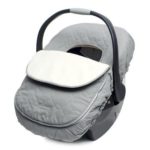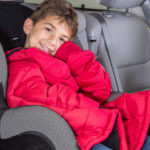How to Keep Children Warm and Safe in a Vehicle During Winter
Winter is here! Wrapping your kiddo in the warmest jacket possible seems the obvious way to stay warm but puffy coats are not the safest option when it comes to car seats and booster seats.
Why is it Unsafe to Wear Some Coats in the Vehicle?
For your child’s car seat to offer the maximum protection in a crash, the harness or seat belt needs to be as close to the child as possible. The more layers of padding or clothing between a child and the harness, the harder it is to properly fit the restraint to the child. The harness can end up fitting to the thick coat, and in the event of a crash, all that extra air is forced out between the layers, leaving the harness too loose to protect a child. A loose harness, at best, means extra crash time on the child, and at worst, could mean ejection from the seat.
How to Check
Here’s a great visual of how loose the car seat’s harness could be in a crash with this coat on the child.

- Put the coat in question on your child. Head out to the car.
- Buckle the child into the car seat.
- Tighten the harness enough to remove all slack at the child’s collarbone.
- Unbuckle the child from the car seat without adjusting the harness.
- Take off your child’s coat, then buckle the child back into the car seat.
In this case, we see that her cute and puffy coat created quite a lot of potentially harmful slack in the harness.
Try it in Reverse
Here’s another way to look at that test.
- Without a coat on, secure your child in their car seat. Tighten the harness as usual so no fabric can be pinched at the collarbone (the pinch test).
- Remove the child from the car seat without adjusting the harness.
- Put the child’s coat on, then try to buckle them back into the car seat.
Take note, properly fitting fleece jackets or sweatshirts do add a bit of bulk to the child’s body and will often require a little harness adjustment. The key here is harness length that remains appropriate to the child’s compressed clothing. With most winter coats, there is a dangerous amount of extra slack due to the uncompressed puffy jacket.
What it Really Takes to Stay Warm
Another important consideration is that children do not need to wear all those layers while in the vehicle. Even if it takes a while for the vehicle to warm up, when it does, the child can become hot, sweaty, and generally cranky if they are dressed in too many layers. Usually, even the tiniest of babies need at most one more layer of clothing than their parents are wearing to be comfortable.
Alternatives
If puffy winter coats is not the safest option, what can you do? Here are some popular options that don’t interfere with the car seat’s harness.
Shower Cap Style Cover

The shower cap style cover goes over the top of a rear facing only car seat. This type of cover doesn’t interfere with the harness at all and is easily removed if the child starts to get too warm. Some styles include a zipper to help adjust the temperature as well.
Backwards Coat

Putting a jacket on backwards over the harness is an easy way to stay warm
Secure the child in the car seat without their coat on.
Once the child is strapped into the car seat, put their coat on them backwards
This method keeps the harness snug to the child and allows the child the freedom to remove their own coat if they become too warm.
Poncho

Ponchos are comfy, safe, and warm!
There are a number of poncho options that work well with car seats. The key feature is that the poncho doesn’t interfere with the harness — the poncho covers the front of the child while adding no extra bulk between the child and the harness.
Blanket and Hat

You can’t go wrong with blankets, a hat, gloves, and warming up the car ahead of time if possible. These are easy to do: after properly tightening a child’s harness or buckling into a booster just tuck a blanket around them.
